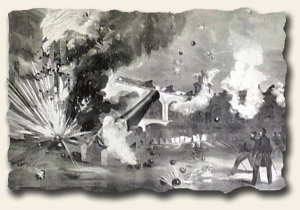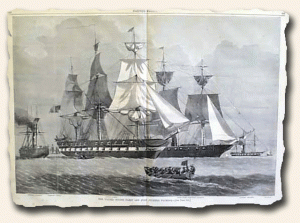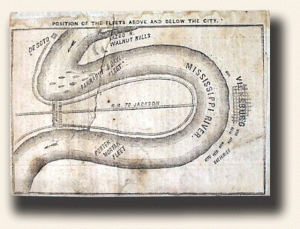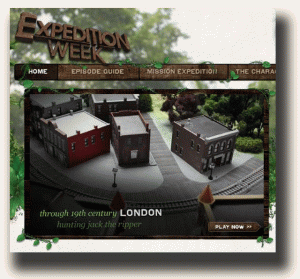Rare Newspapers found on The Freedom Trail…
April 30, 2011 by GuyHeilenman · 1 Comment
 As of April 15, 2011, the historic Freedom Trail welcomed Boston area’s 1st authentic colonial era print shop, The Printing Office of Edes & Gill. While visiting, patrons will have the opportunity to engage living historians working their printers trade in pre-revolutionary Boston. These same printers were at the vanguard of citizen angst over British governmental policies that Bostonians felt violated their rights as Englishmen. They offer unique personal encounters with history and colonial printing. If you have the opportunity to visit Boston, make sure to pay a visit to this great new addition, located along the Freedom Trail at the historic Clough House, which is owned by and conveniently located adjacent to Old North Church. While there, look for a few Rare & Early Newspapers from our archives. In the meantime, enjoy their new website: The Printing Office of Edes & Gill
As of April 15, 2011, the historic Freedom Trail welcomed Boston area’s 1st authentic colonial era print shop, The Printing Office of Edes & Gill. While visiting, patrons will have the opportunity to engage living historians working their printers trade in pre-revolutionary Boston. These same printers were at the vanguard of citizen angst over British governmental policies that Bostonians felt violated their rights as Englishmen. They offer unique personal encounters with history and colonial printing. If you have the opportunity to visit Boston, make sure to pay a visit to this great new addition, located along the Freedom Trail at the historic Clough House, which is owned by and conveniently located adjacent to Old North Church. While there, look for a few Rare & Early Newspapers from our archives. In the meantime, enjoy their new website: The Printing Office of Edes & Gill
The Civil War… 150 years ago today… April 27, 1861
April 27, 2011 by TimHughes · Leave a Comment
We continue our weekly feature of reflecting upon the appropriate 150 year old issue of “Harper’s Weekly” from the perspective of a subscriber in 1861:
Although there is some frustration in waiting two weeks to see the events of the conflict, the prints definitely help in understanding all that is going on. The front page of today’s issue (April 27, 1861) shows “General Thomas Swearing In the Volunteers Called into the Service of the United States at Washington, D.C.” There is also a front page article on “The Bombardment of Fort Sumter” which provides some detail I did not read in the daily papers of two weeks ago. But the real drama of the skirmish comes to life with the full page print: “The Interior of Fort Sumter During the  Bombardment” showing bombs exploding and being hurled through the air by the massive cannons. What a horrendous experience that must have been! The full page “Map of Charleston Harbor” shows how surprisingly small Fort Sumter seems to be, on a small island right in the middle of the harbor. I can not understand what it is a strategic installation for the protection of the city.
Bombardment” showing bombs exploding and being hurled through the air by the massive cannons. What a horrendous experience that must have been! The full page “Map of Charleston Harbor” shows how surprisingly small Fort Sumter seems to be, on a small island right in the middle of the harbor. I can not understand what it is a strategic installation for the protection of the city.
Then, golly, I turn to the center fold to see a terrific print showing the “Bombardment of Fort Sumter by the Batteries of the Confederate States”. It’s full of action, showing the soldiers at their positions next to the cannons and the destruction being done to Fort Sumter in the distance. This print certainly brings the event to life!
Further on is a print of Abraham Lincoln taken from a photograph by the famed photographer Matthew Brady. He looks just like the earlier images I recall from his inauguration. And a special treat is a full-figure print of “General P. G. T Beauregard”, the Confederate commander of the forces in Charleston.
The text in this issue is interesting as well, but the prints are what keep me looking forward to next week’s edition.
Eerie coincidences…
April 25, 2011 by TimHughes · Leave a Comment
The “”Southern Illustrated News” was a somewhat failed attempt by the Confederacy to bring to its citizens an illustrated newspaper similar to “Harper’s Weekly” and “Leslie’s Illustrated“. Although the presumed feature of the Dec. 5, 1863 issue was the front page engraving & biography of Captain William Downs Farley, time caused several innocuous items on the back page to intrigue the historical collector.
The back page has several reports which bring together many of the names involved in the Lincoln assassination that would happen more than a year in the future. Under the theatrical reports is mention that: “…Laura Keene, Mr. & Mrs. Charles Walcott…lately formed an alliance known as ‘Laura Keen’s Combination & have been t raveling through the Northern States…On Monday last huge posters were put out announcing the ‘American Cousin’ with Charles Walcott in one of the principal parts…” Remember that Laura Keene starred in “Our American Cousin”, the performance at Ford’s Theatre the evening of the assassination. Also on the back page: “Edwin Booth is playing in Boston supported by Mrs. Anna Cornell & Mr. Marshall.” He was the brother of John Wilkes Booth. Even his name is here, performing at Ford’s Theatre no less: “The present week is announced as the last of J. Wilkes Booth…at Ford’s New Theatre, Washington, D.C.” And a bit further on is even mention of the President: “…preparatory to his appearance at Richmond in the character of one of President Lincoln’s special peace envoys as already announced…” (see). This single page brings together the names Laura Keene, the play “Our American Cousin”, John Wilkes Booth, Abraham Lincoln, and Ford’s Theatre, an almost eerie coincidence, particularly for a Confederate newspaper.
raveling through the Northern States…On Monday last huge posters were put out announcing the ‘American Cousin’ with Charles Walcott in one of the principal parts…” Remember that Laura Keene starred in “Our American Cousin”, the performance at Ford’s Theatre the evening of the assassination. Also on the back page: “Edwin Booth is playing in Boston supported by Mrs. Anna Cornell & Mr. Marshall.” He was the brother of John Wilkes Booth. Even his name is here, performing at Ford’s Theatre no less: “The present week is announced as the last of J. Wilkes Booth…at Ford’s New Theatre, Washington, D.C.” And a bit further on is even mention of the President: “…preparatory to his appearance at Richmond in the character of one of President Lincoln’s special peace envoys as already announced…” (see). This single page brings together the names Laura Keene, the play “Our American Cousin”, John Wilkes Booth, Abraham Lincoln, and Ford’s Theatre, an almost eerie coincidence, particularly for a Confederate newspaper.
10 Most Shocking Deaths in Sports History…
April 23, 2011 by GuyHeilenman · Leave a Comment
 We recently became aware of another blogger’s post we thought you might appreciate. While rare newspapers bring us news of varied events, none grabs our attention quite like the 1st reports of tragedy. In some cases, the untimely death of an athlete such as Dale Earnhardt, or a musician such as Elvis Presley, are profoundly impacting since they are often so unexpected. It is with this in mind we draw our attention to one writer’s view of the “10 Most Shocking Deaths in Sports History“. You may or may not agree with all of the names on the list, but each story reminds us of the brevity of life, and the anguish when such brevity is realized in the prime of life. Note: The writer, Jena Ellis, has included links to the 1st reports for each person on her list. Feel free to comment.
We recently became aware of another blogger’s post we thought you might appreciate. While rare newspapers bring us news of varied events, none grabs our attention quite like the 1st reports of tragedy. In some cases, the untimely death of an athlete such as Dale Earnhardt, or a musician such as Elvis Presley, are profoundly impacting since they are often so unexpected. It is with this in mind we draw our attention to one writer’s view of the “10 Most Shocking Deaths in Sports History“. You may or may not agree with all of the names on the list, but each story reminds us of the brevity of life, and the anguish when such brevity is realized in the prime of life. Note: The writer, Jena Ellis, has included links to the 1st reports for each person on her list. Feel free to comment.
“The 10 Most Shocking Deaths in Sports History“
The Civil War… 150 years ago today… April 20, 1861
April 20, 2011 by TimHughes · Leave a Comment
We continue our weekly feature of reflecting upon the appropriate 150 year old issue of “Harper’s Weekly” from the perspective of a subscriber in 1861:
 “This week’s edition has many prints on the Civil War, just as I was hoping. Reading the reports in the daily papers I looked forward to see what was happening. The front page has a nice view of “The Confederate Batteries Opposite Fort Pickens, Florida” which shows the formidable size of the fort. An inside page has an interesting 5 panel print of “Commander Dahlgren, U.S.N. and the Dahlgren Gun”, a cannon mounted on wheels. It’s interesting that they take a full page to show a print of “The Washington Navy-Yard with Shad Fishers in the Foreground”, but what I found most interesting is the partially completed dome of the New Capitol building under construction in the nation’s capital. It would seem to be the tallest structure in town!
“This week’s edition has many prints on the Civil War, just as I was hoping. Reading the reports in the daily papers I looked forward to see what was happening. The front page has a nice view of “The Confederate Batteries Opposite Fort Pickens, Florida” which shows the formidable size of the fort. An inside page has an interesting 5 panel print of “Commander Dahlgren, U.S.N. and the Dahlgren Gun”, a cannon mounted on wheels. It’s interesting that they take a full page to show a print of “The Washington Navy-Yard with Shad Fishers in the Foreground”, but what I found most interesting is the partially completed dome of the New Capitol building under construction in the nation’s capital. It would seem to be the tallest structure in town!
The double page centerfold has a dramatic presentation of; “The United States Fleet Off Fort Pickens, Florida”–what beautiful ships! This one could be framed. I’m hoping next week’s edition will show scenes of the battle of Fort Sumter in Charleston Harbor. I’ve read all about it, now I want to see it!”
To enjoy the images (and some of the text) from this issue, please go to: Harper’s Weekly, April 20, 1861
Confederate “Extra” with content from two eras…
April 18, 2011 by TimHughes · Leave a Comment
 Finding oddities from the newspaper world is part of the fun of the hobby, and recently one came our way which I found to be very unusual.
Finding oddities from the newspaper world is part of the fun of the hobby, and recently one came our way which I found to be very unusual.
The “Daily Appeal–Extra” newspaper from Memphis, Tennessee dated April 20, 1861, contains content which is over two years apart. This is a “broadside extra” edition meaning the narrow sheet was published to report a specific event, and printed on one side only. But in this case, the reverse is not entirely blank.
First, it’s curious that this is a newspaper from a city which was only “Confederate” until the battle of Memphis, June 6, 1862, after which it was in Yankee control. The front has a very nice graphic devise at the top of the first column showing a cannon and Confederate flag, with heads: “THE WAR NEWS ! ” “Star of the West Taken As A Prize ! “and other related heads & reports.
But the most intriguing aspect of this issue is the back page. Although I am convinced this was issued in 1861 with the reverse blank, it nonetheless has a print of a map of the Vicksburg vicinity, and nothing else. Now, let’s keep in mind that the siege of Vicksburg didn’t happen until mid-May, 1863 thru its fall to the Yankees on July 4, 1863. Note that the heading of the map reads: “Position of the Fleets Above and Below The City” showing the positions of both Porter’s and Farragut’s fleets. Their appearance in the Mississippi did not happen until 1863. I surmise this “Extra” edition was lying around the printing office and since the back side was blank they used it as a test sheet for printing this map, which likely appeared in a the “Memphis Appeal” newspaper at some point in May, June, or July, 1863. Consequently this becomes a truly fascinating curiosity to have printings from two different periods in a single issue, and one being a map.
Do any fellow collectors have another explanation?
Rare Newspapers found on the National Geographic Channel…
April 16, 2011 by GuyHeilenman · Leave a Comment
 Early this month National Geographic Channel surfers had the opportunity to add an authentic 19th century London Times with a report regarding Jack the Ripper to their personal collection, for no cost. Three issues from the Timothy Hughes Rare & Early Newspapers Archives had been donated for use as prizes in the latest Mission Expedition featured on the National Geographic Channel’s website. Although the “expedition” is over, the website shows great behind the scenes footage of how the project was created. These interactive walks into the past also provide wonderful opportunities to engage young budding historians. To view the footage, go to: National Geographic Channel: Mission Expedition. the next expedition will be in October of 2011.
Early this month National Geographic Channel surfers had the opportunity to add an authentic 19th century London Times with a report regarding Jack the Ripper to their personal collection, for no cost. Three issues from the Timothy Hughes Rare & Early Newspapers Archives had been donated for use as prizes in the latest Mission Expedition featured on the National Geographic Channel’s website. Although the “expedition” is over, the website shows great behind the scenes footage of how the project was created. These interactive walks into the past also provide wonderful opportunities to engage young budding historians. To view the footage, go to: National Geographic Channel: Mission Expedition. the next expedition will be in October of 2011.
The Civil War… 150 years ago today… April 13, 1861
April 13, 2011 by TimHughes · Leave a Comment
We continue our weekly feature of reflecting upon the appropriate 150 year old issue of “Harper’s Weekly” from the perspective of a subscriber in 1861:
“The daily papers today give evidence of what everyone feared: war has begun. Events in Charleston harbor reached a breaking point as both the North and the South claimed the military installations there. But our “Harper’s Weekly” is about two weeks late with reports which I understand is due to the complexity of providing accurate illustrations of the events, certainly a small price to pay for the great benefit of “seeing” the war scenes. I look forward to the end of the month and seeing just what transpired at Charleston.
In the meantime today’s issue has a scene of Point Isabel, Texas, a town apparently on a cliff along the Gulf of Mexico. In the foreground troops are being transported on a paddle-wheeler. Near the back are two military scenes including a boat house at Fort Pickens, Florida, and another the inside of that fort. The cannons they use are huge and the fort’s thick walls seem impenetrable. I had not previously known what the inside of a fort looked like.
I recognize President Lincoln in one of the back page cartoons, his face and stature familiar from an earlier issue on his inauguration. In this cartoon he consults with “Columbia”, who says: “…be sure you’re right, then go ahead!” Yes, our future is in his hands.” With all of the tension in the air, I was surprised to see the double-page centerfold which included various vignettes of American Home Scenes, which seemed in stark contrast to the mood of the day.
To enjoy the images (and some of the text) from this issue, please go to: Harper’s Weekly, April 13, 1861
Antebellum American Newspapers… AAS…
April 11, 2011 by GuyHeilenman · Leave a Comment
Vincent Golden of the American Antiquarian Society, recently produced a video which describes the history and characteristics of Antebellum American newspapers. We thought our readers might enjoy this informative piece, from the Curator of the AAS:
Antebellum American Newspapers from American Antiquarian Society on Vimeo.
The early muckrakers – collecting newspapers that dished the dirt…
April 9, 2011 by GuyHeilenman · Leave a Comment
The following is a guest post submitted by Edward Khoo:
People collecting old and rare newspapers will give you many different reasons for their
hobbies. For some it’s about owning a little piece of history, for others it’s a way of connecting
to important date in their life – say a birthday or marriage – to something real. For some it’s
just that wonderful sense of smell and touch you get from handling something that was meant
to be thrown away – fragile, disposable, but now wonderfully evocative.
But once you get past those initial reasons, many of us newspaper-collectors like to build our
collections around favorite themes, to give us a focus. And there’s a lot to choose from – you
can collect papers just from your local area, where a lot of the stories may have some real
relevance to the people still living in your town or county. Or you can collect on a particular
important news story, or historical theme – I know one guy who has collected editions only on
dramatic murder cases. Though maybe you should avoid that sort of collector, because you
don’t know where it’s going to lead!
For me, though, it’s the history of the newspaper journalism that fascinates me. It’s simply
amazing to be able to see how much has changed, in journalistic style, over the last 200
years – and how much has stayed the same! And the wonderful, and surprising, thing about
collecting rare and old newspapers is the fabulous state of preservation many of these copies
are still in.
You may expect that newspapers older than 50 years would just crumble in your hands –
but you’d be wrong. Although the newspapers we find when we lift the carpet are usually
yellowing and fragile – after just 10 or 20 years – back-in-the-day they made them very
differently. Most of the earlier 19th century papers were made from a type of linen, not paper,
which ages very well – so some very ancient newspapers can look almost pristine!
The period that I’m particularly interested in dates back to that century – those great
champions of newspaper journalism, who set the standard for the humbling of the powerful
– the ‘muckrakers’. That term was coined by a certain Theodore ‘Teddy’ Roosevelt, who
compared those who sought to expose ‘many grave evils’ in the ‘body politic’ to a character
from John Bunyan’s Pilgrim’s Progress : ‘Man with the Muck-rake, the man who could look no
way but downward, with the muck-rake in his hand.’
That, for me, is where journalism shines most bright – when its delving deep into the dirty
underbelly, and exposes it for all to see. We wouldn’t have a true democracy at all without
those guys. So where do you start, if you want to collect some of the finest examples of
exposé-journalism?
Well, one of my favorites is a woman who was a pioneer on several fronts – Nellie Bly. Not
only was she a journalist at a time when the fairer sex was frowned upon for doing anything
except being mothers, and supporting ‘their men’ – she also broke the record for going around
the world, beating Phileas Fogg. Her journalistic exploits were groundbreaking, so owning so
me the newspaper she printed in is to hold onto social history in the making.
She really made her name at Pulitzer’s New York World, with her undercover work in an
asylum. She actually managed to get herself committed, so as to show what really went on in
the mental institutions of the time. The paper had a big circulation, so picking up copies is notinsanely hard (excuse the pun). But some of her more interesting work was on the Pittsburgh Dispatch, on which she worked as a foreign correspondent in Mexico. These papers are rarer – so naturally more valuable.
Another principled muckrakers, on the west coast this time, was Fremont Older. He wrote for
first the San Francisco Bulletin, and then for William Hearst’s San Francisco Call, at the turn
of the last century. He had a knack for getting up the noses of local politicians, such as the
corruption machine of Abe Ruef, just after the San Fransisco quake. We could probably do
with more of his ilk on today’s San Francisco Examiner!
That’s the wonderful thing about this hobby. Whatever slice of real life you’re interested in, the
rags and hacks of the past will have covered it in one way or another. By collecting those thin
sheets of typeset from the past, you’re opening a window onto how the world has changed –
and yet is still very much the same.
Edward Khoo is a writer who is proud of his language and based in one of the exotic and
tropical islands of Malaysia.


